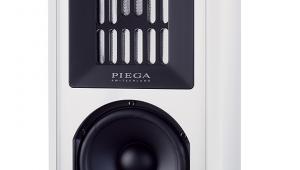Sonus Faber Guarneri Evolution (£12,490)

What follows 'The Sonus faber'? A second revision of the Guarneri, the company's best-selling high-end loudspeaker
What hasn’t been reduced is the price. To get this odious matter right out of the way, the Evolution sells for £9998 for the speakers, plus £2852 for the stands, or £12,490 if you buy them together – the saving equates to a pair of fine speaker cables. Lest you still find this horrific, the Homage’s £5500 of 18 years ago now equates to around £10,500, and VAT wasn’t 20% in 1993.
SIGNIFICANT CHANGES
So Sonus faber isn’t being greedy. And what you get is more than a facelift. The only visual clues are slight changes in dimensions and a more sculpted, angular baffle, yet the speaker has been totally redesigned.
In typically florid Italian fashion, though, the ‘rationale’ is the stuff of romantic copywriters. Check out this choice line from the literature: ‘If Homage and the following Memento recall the most precise and traditional works of Giuseppe Guarneri del Gesù, the Evolution version initiates a stylistic change that mirrors the path of the master violin maker, forever searching for that “Timbre”, evocative and sensual.’ OK, it certainly beats such soulrattling temptations as ‘higher sensitivity’ or ‘hand-wound resistors’, especially when you consider that the ultimate goal is music reproduction. In causing Guarneri to ‘mature to superior levels of quality, without undermining the original spirit’, the company changed drivers and applied the advances of The Sonus faber £140k fl agship into the smaller speaker’s cabinetry [see HFN Feb ’11].
Retained is the basic configuration in a rear-ported enclosure with dedicated, if optional, stand. From its largest sibling, the speaker is said to inherit improved speaker/ fl oor decoupling through ‘LVT’ (Low Vibration Transmission) – a system using a specifi callyoptimised elastomer suspension. The ‘TMD’ (Tuned Mass Damper) device is claimed to further squash residual resonances, while the ‘Stealth’ reflex design shaped the port. For drivers, the company employs a special version of the Ragnar Lian 29mm silk dome tweeter, visco-elastically decoupled from the front baffle. The Evolution version has been tweaked in order to improve the extreme high frequencies and to minimise anti-phase behaviour at the centre of the dome.
The Evolution’s 7in mid/woofer uses a diaphragm made of cellulose pulp stabilised through natural air drying. Papyrus has been added to the cellulose pulp as per The Sonus faber, along with other natural fi bres including Kapok, ‘the lightest natural fibre in the world’, and Kenaf, a fi bre similar to hemp. It’s fi tted with a 1.7in voice-coil and, like the tweeter, is visco-elastically decoupled from the front baffle. The drivers cross over at 2.8kHz.
Perhaps the most signifi cant difference between the Evolution and its predecessors, and owed entirely to The Sonus faber, is its ‘Anima Legata’. It’s why the speaker has the CNC-machined, nickel-plated, solidmetal exoskeleton. Anima Legata (literally ‘soul linked’) was conceived to reduce the transmission of ‘spurious vibrations’ into the listening environment, while inhibiting acoustic feedback. It connects the top and bottom plates of the enclosure – a giant clamp, as it were.
NARROWING THE GAP
Even without undertaking the final set-up, in an initial burst the Evolution’s relationship to its predecessors manifested itself like that of an M Series BMW’s correlation to a stock 3-Series: hot-rodded, breathed-on, pumped up with steroids. While the Homage and Memento were hardly wimps, this one kicks sand in their faces. And it all starts with the bass.
I lack the mental agility to calculate the difference in surface area between a 5in and 7in woofer, but the Evolution breaks free from any shackles one might assumed would be imposed by its driver or cabinet size. It acts like a much bigger speaker. But note that throughout this review I am referring to the speaker mounted on its dedicated stand, which is mandatory for extracting the most out of the Guarneri. Why they are even offered separately is beyond me, because using these on a bookshelf will rob them of the three-dimensionality, openness and air that make them such miracle workers, regardless of which generation they are.
What the stands contribute are ideal height and angling for an equilateral triangle set-up, its point crossing just in front of the listener. But here’s something else the Evolution adds to the recipe: unlike the to-the-millimetre toe-in requirements of the Homage and Memento, the new model even delivers 90% of the imaging with the speakers fi ring directly forwards. If any speaker on a stand, which can’t be hidden away or positioned up against the wall, can be positioned with wife-pleasing wiggle room, this is it.
All of the above was made apparent when listening to Keb’ Mo’s Peace... Back By Popular Demand, with its beautifullyrecorded bass guitar, natural-sounding piano, tight percussion and bottleneck guitar. In front of it all, that velvety vocal. It was not the bass that concerned me, because it was clear from the first bars that the Evolution narrowed the gap between the Guarneri and its natural rivals: speakers like Wilson Sophia 3s, the smaller Magicos, Avalons and other compact floorstanders.
By virtue of larger enclosures and more wooferage, such rivals still sound richer; but gone is the sensation that earlier Guarneris posited, that of being slightly ‘lightweight’. It was enough that the bass sounded more extended, more fulsome, while the spatial concerns bloomed by 20% or more, and in every direction. Some live Dave Alvin, in intimate clubs, with a swampy, rootsy, rocking band, seemed more convincing, more authentic, by virtue of the increase in front-to-back depth, and the air and transparency allowing you to hear an approximation of the room. Any traces of spatial congestion simply vanished.
It was with fragile female vocals, from Lori Lieberman or Eleanor McEvoy, where previous Guarneris showed their stuff. The utter aplomb with which the Guarneri handled delicate voices, acoustic guitar, gently bowed strings, made the speaker an audiophile default purchase for almost two decades. So would the transformation of the bottom octaves, the added lower mass and impact, come at somewhat too high a price?
BAD-ASS BROV’
Er, yes and no. The Evolution is, like the earlier models, tough on amplifiers. It would not, for example deliver its dynamic contrasts with the Quad II Classic Integrated or the McIntosh MC275. Instead, it needed a brace of Quad II eighty monoblocks, or McIntosh’s MC2102, and I suspect it would sing like Rita Pavone with the D’Agostino ramming 300W into its terminals. But the nature of the treble has changed, too, so consider that when mating to an amplifi er of adequate output – ordinarily, delicacy is the preserve of medium power amps, like classic 60- or 75-watters. Earlier Guarneris shimmered on strings, sounded liquid on the Judds or Crystal Gayle, and provided the requisite smokiness for Nat ‘King’ Cole. The new tweeter has brought to the upper frequencies what the new woofer applied to the bottom: there’s more of it, so to speak, with heightened precision, faster attack.I wasn’t off the mark with my earlier automotive analogy: drive a stock 3-Series BMW, then an M3 over the same winding road. The added tautness, excitability, speed – they’re tangible. Now think of that as applied to Guarneri’s well-known sonic behaviour. This Evolution is the Homage’s and Memento’s bad-ass kid brother.
VERDICT
Detroit used to describe its new cars as ‘Longer! Lower! Wider!’ Here it’s ‘Deeper! Shorter! Narrower!’ And add to that ‘better’ if you value deeper bass and a larger soundstage. Evolution moves on from Homage as Barolos have changed: modern versions have more kick, less delicacy. So, if you loved the original for its grace, keep it. But if you need that extra 2% more alcohol, drink deeply of the Evolution.
Originally published in the November 2011 issue
























































